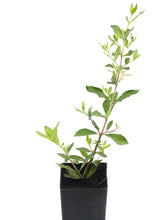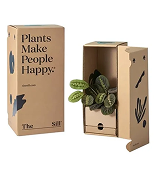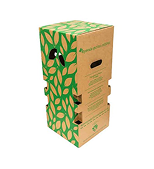- Home
- All In Stock - ExoticFLora
- Lawsonia inermis/Henna/Mehendi Plant -...
Lawsonia inermis/Henna/Mehendi Plant - Plant





Lawsonia inermis/Henna/Mehendi Plant - Plant




Damaged or lifeless? We’ll replace it for free. Learn more

Double layered custom boxes to protect plants during shipping.

Air vents for proper air-flow

To preserve plant freshness during transit

Details steps of how to grow and maintain your plant
Henna is Botanically known as Lawsonia inermis from the Lythraceae family. In India commonly known as Mehendi in Hindi. It is a tall shrub to the small tree that can grow up to 1.8 to 7.6 m tall. It is glabrous and multi-branched, with spine-tipped branchlets. You can also be used it for Natural Hedge/Border Plants. Can be easily grown in Pots & easy to grow at all kind of soil with very low maintenance.
It produces the most dye when grown in temperatures between 35 and 45 °C. During the onset of precipitation intervals, the plant grows rapidly, putting out new shoots. Growth subsequently slows. The leaves gradually yellow and fall during prolonged dry or cool intervals. It does not thrive where minimum temperatures are below 11 °C. Temperatures below 5 °C will kill the henna plant.
Henna Growing Benenfits
- It is the source of the dye henna used to dye skin, hair, and fingernails, as well as fabrics including silk, wool & leather.
- Medicinal properties for the cure of renal lithiases, jaundice, wound healing; prevent skin inflammation.
- The bark is traditionally used in the treatment of jaundice and enlargement of the spleen, renal calculus, leprosy, and obstinate skin diseases.
- The name henna refers to the dye prepared from the henna plant and the art of temporary tattooing based on those dyes.
- Leaf extract is used as herbal remedies for diarrhea, amoebic dysentery, ulcers, tapeworms, jaundice, leprosy, and fever.
- It is applied to burns, wounds as it adds a protective layer against foreign pathogens and gives a cooling effect.
- Henna oil has been directly related to alleviating certain sleep disorders like insomnia
- Henna increases the strength of the hair and, hence is a safe dye, it keeps dandruff away
- Fibers of branches, stem bark are used to make baskets and twigs are used as toothbrushes.
INSIDE THE BOX
| S.No. | PRODUCT NAME | DIMENSION |
| 1. | Henna Plant | 1-2 Feet Height |
| 2. | Growing Pot (Black color) | 6 Inch |
*above specifications are for indicative purposes only, actual dimensions may slightly vary.
INITIAL CARE FOR 10-15 DAYS JUST AFTER RECEIVING YOUR PLANT
- Remove the Packaging Materials carefully.
- Press the soil in the pot & add additional soil(garden mix) if necessary.
- Maintain moisture in the pot, Do not overwater it may kill your plant, so make sure that the soil should be dry between watering.
- Make sure that plants get enough morning direct bright light(2-3hrs) for 10-15 days & do not go for immediate transplanting (minimum 1 month)
- After 1 month you can transplant it into slightly bigger pot than the present pot or you can remain in the same pot for 6-7 month.
- Just prune if any branch of the plant is get damaged in transits. New leaves will come definitely.
Selected plant of 8-10 inches
Planted into a 5-inch pot
With healthy, moisture-retaining soil
A care instruction sheet for maintenance guide

Get in touch for best pricing on bulk orders and landscaping projects.
 WhatsApp us
WhatsApp us

Call on 9177805454 (Mon-Sat, 9 AM-6 PM) or WhatsApp us – we’re here to help.
About Exotic Flora
At Exotic Flora, we’re passionate about bridging the gap in bringing plants to everyone. With over 500+ varieties across 7 plant categories, from exotic finds to everyday greens, we bring the entire range to you.
Our plants, sourced from all parts of India are nurtured at Kadiyam, in our 25 acres in-house nursery by a team of expert horticulturists. Once they are ready we ship all our plant varieties across India.
Our services go beyond safe delivery of plants. A dedicated support team is there to help you with any maintenance queries you may have.
At Exotic Flora we always believe in going that extra mile, because everyone should have the plants they love.
Every plant has different plant parts to use as a medicinal plant it may be in its leaves, roots, stems, flowers or other parts of the plant. For full details look at the descriptions of individual plants.
Citronella grass, Lemon grass, Rosemary, Marigold, Mint Tulasi etc
Some plants need indirect bright light & others need direct bright light and some can grow in both direct and indirect sunlight. So please look at the description of each individual plants.
The soil should be well drained, fertile and rich in organic content. A mixture of garden soil, cocopeat, compost will give the best results for your plants.
Remember overwater can kill your plant(make sure that your pot should have drainage hole). Water when the topsoil(2-3 inch) feels dry to touch. In general moderate watering(in every 3-4 days)
Regular pruning of diseased and damaged parts of the plants. Regular watering, proper ventilation & sunlight, organic manure & fertilizers application.
In general you can grrow in indirect bright light conditions like basil, rosemary, mint, Centella asiatica, Maghai paan / betel leaf.
Tulsi has been used for thousands of years in Ayurveda for its diverse healing properties apart from devotional purpose.
No, both are different plants, Tulsi which is commonly known as holy basil, where as mint tulsi is closely related to holy basil & doesn't have devotional property.
Stevia is a sugar substitute made from the leaves of the stevia plant. It's about 100 to 300 times sweeter than table sugar, but it has no carbohydrates, calories, or artificial ingredients.
Costus igneus, commonly known as insulin plant in India. Consumption of the leaves are believed to lower blood glucose levels, and diabetics.